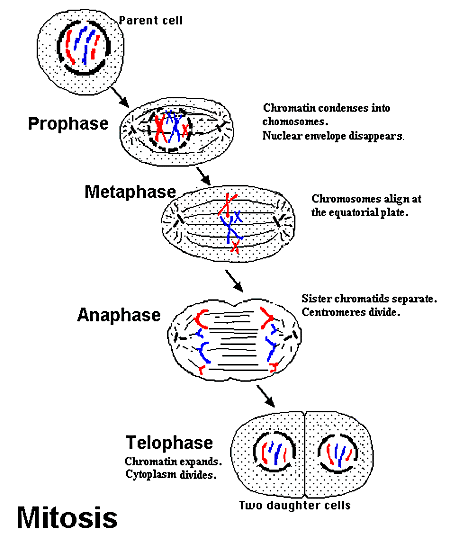They are visible in mitotic phases. Chromosomes are not visible in interphase and three phases will be G1 S and G2.
6 2 The Cell Cycle Concepts Of Biology 1st Canadian Edition
What is the phase.

. What is the phase. Telophase cytokinesis and interphase. The three phases in which the individual chromosomes are no longer visible are interphase telophase and cytokinesis.
Spindle fibers form between the centrioles which go to the polar ends of the cell. On the other hand mitosis is the simple division of cell into two daughter cells. During which three phases are individual chromosomes no longer visible.
Interphase is made up of three phases. Metaphase The centromeres of chromosomes attach to spinde fibers which change in length pulling the chromosomes into a line along the equator. Telophase cytokinesis and interphase What stage does a cell spend most of its cycle in.
Telophase cytokinesis and interphase. Phase Sketch Summary - The cell grows - Cell prepares to be divided - Duplicates DNA - The DNA is very long fine at this stage Interphase - Nuclear membrane dissolves - Nucleolus also disappears - DNA condenses into a tight form seen under the microscope as chromosomes - Each chromosome is made up of 2 duplicates which are known as sister chromatids that are. The nuclear membrane dissolves near the end.
Hence it takes longer time to perform this crucial events. Each chromosome consists of a pair of identical chromatids attached together by a structure called a. The spindle fibers pull the chromosomes to line them up on the equator.
During which three phases are individual chromosomes no longer visible. During which three phases are individual chromosomes no longer visible. During which three phases are individual chromosomes no longer visible.
During this stage chromosomes as well as DNA content doubles. ___ Telophase ____ G. During which three phases are individual chromosomes no longer visible.
Why is it important that the cells DNA is duplicated before cell division. Telophase A nucleus forms around each of the chromosomes. In which phase does a new nuclear membrane develop.
A cell has a single line of chromosomes. G1 S G2 phase. During which three phases in cell division are individual chromosomes no longer visible.
What is the role of the centrioles. During interphase the cell grows G1. ___ Telophase ____ G.
_____they produce the spindle fibers and pull apart the chromosomes_ F. What is the role of the centrioles. During which three phases are individual chromosomes no longer visible.
If the cells DNA werent duplicated then each daughter cell would only get half of a complete set of DNA. Why is it important that the cells DNA is duplicated before cell division. What is the phase.
A cell has a single line of chromosomes. Human cells have 46 chromosomes. G1 which is cell growth S DNA synthesis and G2 is cell division or cell growth.
_____they produce the spindle fibers and pull apart the chromosomes_ F. Anaphase The chromosomes are split apart by the fibers and the chromatids move to opposite sides of the cell. This stage is divided into three parts.
In which phase does a new nuclear membrane develop. However during cell division mitosis the chromosomes become highly condensed and are then visible as dark distinct bodies within the nuclei of cells. Interphase is the stage where a cell prepares itself for division.
Prophase The nucleolus disappears and chromatin condenses to form chromosomes. During prophase the chromosomes form and the nuclear envelope and the nucleolus are no longer visible. Phase Sketch Summary Interphase Prophase Metaphase Anaphase Telophase Cytokinesis Activity A continued on next page that the cell spends a lot of time in inter-phase and the process of splitting is very fast Cell grows DNA copied new organelles formed x x x x Chromosomes formed from chromatin nuclear membrane dissolves spindle fibers formed.

Cell Cycle M Phase An Overview Sciencedirect Topics

Cell Cycle M Phase An Overview Sciencedirect Topics

0 Comments